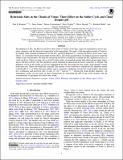Hydroxide salts in the clouds of Venus : their effect on the sulfur cycle and cloud droplet pH
Abstract
The depletion of SO2 and H2O in and above the clouds of Venus (45-65 km) cannot be explained by known gasphase chemistry and the observed composition of the atmosphere. We apply a full-atmosphere model of Venus to investigate three potential explanations for the SO2 and H2O depletion: (1) varying the below-cloud water vapor (H2O), (2) varying the below-cloud sulfur dioxide (SO2), and (3) the incorporation of chemical reactions inside the sulfuric acid cloud droplets. We find that increasing the below-cloud H2O to explain the SO2 depletion results in a cloud top that is 20 km too high, above-cloud O2 three orders of magnitude greater than observational upper limits, and no SO above 80 km. The SO2 depletion can be explained by decreasing the below-cloud SO2 to 20 ppm. The depletion of SO2 in the clouds can also be explained by the SO2 dissolving into the clouds, if the droplets contain hydroxide salts. These salts buffer the cloud pH. The amount of salts sufficient to explain the SO2 depletion entails a droplet pH of ∼1 at 50 km. Because sulfuric acid is constantly condensing out into the cloud droplets, there must be a continuous and pervasive flux of salts of ≈10-13 mol cm-2 s-1 driving the cloud droplet chemistry. An atmospheric probe can test both of these explanations by measuring the pH of the cloud droplets and the concentrations of gas-phase SO2 below the clouds.
Citation
Rimmer , P B , Jordan , S , Constantinou , T , Woitke , P , Shorttle , O , Hobbs , R & Paschodimas , A 2021 , ' Hydroxide salts in the clouds of Venus : their effect on the sulfur cycle and cloud droplet pH ' , The Planetary Science Journal , vol. 2 , no. 4 , 133 . https://doi.org/10.3847/PSJ/ac0156
Publication
The Planetary Science Journal
Status
Peer reviewed
ISSN
2632-3338Type
Journal article
Description
Funding: P.B.R. thanks the Simons Foundation for funding (SCOL awards 599634). P.W. acknowledges funding from the European Union H2020-MSCA-ITN-2019 under Grant Agreement no. 860470 (CHAMELEON).Collections
Items in the St Andrews Research Repository are protected by copyright, with all rights reserved, unless otherwise indicated.

